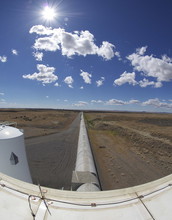Press Statement 16-012
LIGO begins next search for gravitational waves
NSF director reflects on the Laser Interferometer Gravitational-wave Observatory's newest quest
November 30, 2016
This material is available primarily for archival purposes. Telephone numbers or other contact information may be out of date; please see current contact information at media contacts.
Statement from National Science Foundation Director France Córdova regarding news that, after a series of upgrades, researchers have reactivated the twin detectors of the Laser Interferometer Gravitational-Wave Observatory (LIGO), and resumed the search for ripples in the fabric of space and time known as gravitational waves.
"The last time scientists from the NSF-funded Laser Interferometer Gravitational-wave Observatory (LIGO) searched for gravitational waves, they succeeded. They detected gravitational waves from merging black holes 1.3 billion light years away. Researchers devoted more than 40 years to get to this point, and the National Science Foundation -- I'm proud to say -- was there all along the way, providing critical support to make this scientific achievement possible. Today, that journey continues. Already LIGO has exceeded our expectations, and, like most of the scientific world and beyond, I am excited to see what a more sensitive, upgraded LIGO will detect next.
"The significance of this expanding 'window to the universe' cannot be stressed enough, as it will illuminate the physics of merging black holes, neutron stars and other astronomical phenomena that cannot be reproduced in a laboratory setting. The world waits with eager anticipation of what we will see and learn next, all because of the long-range vision and skills of hundreds of researchers around the world."
-NSF-
Media Contacts
Ivy F. Kupec, NSF, (703) 292-8796, email: ikupec@nsf.gov
Related Websites
MIT LIGO: https://www.advancedligo.mit.edu/
Caltech LIGO: https://www.ligo.caltech.edu/
LIGO Scientific Collaboration: http://ligo.org/
The U.S. National Science Foundation propels the nation forward by advancing fundamental research in all fields of science and engineering. NSF supports research and people by providing facilities, instruments and funding to support their ingenuity and sustain the U.S. as a global leader in research and innovation. With a fiscal year 2023 budget of $9.5 billion, NSF funds reach all 50 states through grants to nearly 2,000 colleges, universities and institutions. Each year, NSF receives more than 40,000 competitive proposals and makes about 11,000 new awards. Those awards include support for cooperative research with industry, Arctic and Antarctic research and operations, and U.S. participation in international scientific efforts.
Connect with us online
NSF website: nsf.gov
NSF News: nsf.gov/news
For News Media: nsf.gov/news/newsroom
Statistics: nsf.gov/statistics/
Awards database: nsf.gov/awardsearch/
Follow us on social
Twitter: twitter.com/NSF
Facebook: facebook.com/US.NSF
Instagram: instagram.com/nsfgov



